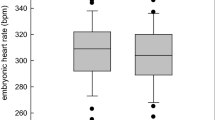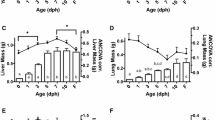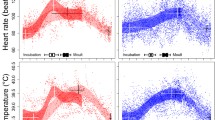Abstract
The developmental patterns of mean heart rate (MHR) and instantaneous heart rate (IHR) were investigated in embryos and chicks of altricial Corvuscorone and Corvus macrorhynchos. The MHR of embryos increased linearly with time from 250 beats · min−1 at mid-incubation to 290 beats · min−1 in hatchlings. MHR during the pipping period was maximal, but only marginally higher than in hatchlings. MHR was stable at about 290–300 beats · min−1 during the 1st week after hatching. Spontaneous heart rate (HR) decelerations and accelerations were found in embryos and chicks, disturbing the baseline HR with increasing frequency during development. However, the IHR accelerations developed later and were less frequent than in precocial species. IHR and body temperature decreased during mild cold exposure (23–25 °C) and IHR accelerations were reduced in nestlings during the 1st week. We suggest that the development of parasympathetic control of HR in crows occurs at 60% of incubation, similar to precocial embryos, but sympathetic control may be delayed and suppressed in contrast to precocial embryos.
Similar content being viewed by others
Author information
Authors and Affiliations
Additional information
Accepted: 3 March 1999
Rights and permissions
About this article
Cite this article
Pearson, J., Tazawa, H. Ontogeny of heart rate in embryonic and nestling crows (Corvus corone and Corvus macrorhynchos). J Comp Physiol B 169, 256–262 (1999). https://doi.org/10.1007/s003600050219
Issue Date:
DOI: https://doi.org/10.1007/s003600050219




